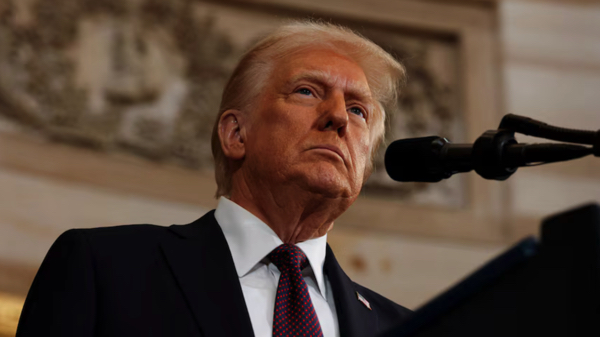 Parler
Parler Gab
Gab
- The U.S. economy added 139,000 jobs in May, below most forecasts, after downward revisions to prior months trimmed 95,000.
- Federal government employment fell by 59,000 since January, as Trump administration policies prioritize reduced bureaucracy.
- Manufacturing employment dropped 8,000 jobs, with tariffs cited as a drag on production and trade.
- Rising wages outpaced inflation, but economic uncertainty kept unemployment steady at 4.2% amid a shrinking labor force.
- Analysts warn of slowing growth ahead as trade policies and federal job cuts test the labor market’s resilience.
Mixed signals in employment data highlight economic uncertainty
The jobs report revealed a labor market out of sync with itself. Private-sector employers added 140,000 positions, exceeding expectations, but this growth was offset by a contraction of 5,000 jobs in “goods-producing” sectors like manufacturing, which lost 8,000 roles. Professional and business services, which historically drive job growth amid expansion, shed 18,000 workers, pointing to broader caution among firms. Meanwhile, service-sector hiring surged, with hospitals, restaurants and transportation firms adding nearly 110,000 jobs collectively. The federal workforce, however, continued its steep decline, dropping 22,000 in May alone and totaling 59,000 reductions since January — a metric advocacy groups argue understates the true impact, as many workers retained on administrative leave still count as employed. “The administration’s push for smaller government is having an unmistakable effect on federal staffing,” said Barclays economist Ajay Rajadhyaksha. “The question is whether these cuts are creating savings or stifling public amenities like airport security and environmental regulation.”Tariff-driven manufacturing decline sparks fears of broader slowdown
Manufacturing’s role as a jobs engine has stalled, with 8,000 jobs vanished in May and data showing tariffs dragging on orders, output and hiring. A survey by the Institute for Supply Management highlighted the toll: 60% of factory managers reported new export orders decline, while 57% cited tariff-related disruptions. One respondent dryly noted, “Chaos does not bode well for anyone, especially when it impacts pricing.” The sector’s struggles come as Trump’s 50% steel and aluminum levies and lingering car tariffs deter businesses from investing in U.S. operations. Even sectors shrugging off pain, like healthcare, face headwinds. Hospitals added 62,000 jobs in May, but employment growth across industries is narrowing. Retailers cut 6,500 jobs, while construction hiring stagnated. “The tariff and federal-cut combo is squeezing firms that can’t raise prices without pushing customers abroad or into bankruptcy,” said Kathy Bostjancic, chief economist at Nationwide.Labor force participation slump casts shadow over “full employment” claims
The unemployment rate’s stagnation at 4.2% masks a disheartening reality: nearly 625,000 Americans left the workforce in May, the sharpest drop in four years. The labor force participation rate dipped to 62.4%, a multi-decade low, as immigration crackdowns — curbing work permits for hundreds of thousands of migrants — shrink the pool of available workers. Industries reliant on low-cost labor, like agriculture and hospitality, now face shortages despite job openings. “Employers aren’t hiring as much, but immigration policies have also eliminated a buyer of last resort for certain work,” said EY-Parthenon economist Lydia Boussour. Wage growth offered a silver lining: Average hourly earnings climbed 3.9% year-on-year, far outpacing the Fed’s 2% inflation target. Yet officials remain wary of a rate cut, citing Trump’s erratic trade strategy as a knot they cannot untie. “The Fed will hold steady until they’re sure tariffs aren’t reigniting inflation or sending growth into a tailspin,” said Capital Economics’ Paul Ashworth.Economic crossroads defined by conflict and cuts
The May jobs report underscores a labor market adrift, buffeted by mutually reinforcing headwinds. Federal hiring cuts — the steepest since the Reagan era — and restrictive trade policies have eroded business and worker confidence, even as wages rise. With tariff disputes unresolved and immigration enforcement intensifying, forecasters predict job gains could slow to 75,000 monthly by year’s end. For policymakers, the challenge is stark: Cease policies seen as self-defeating, or risk ceding ground to recessionary pressures now creeping in at the margins. As one White House economist put it, “We’re testing the limits of how far you can shrink government before it starts collapsing.” The data suggests the experiment is nearing its end. Sources for this article include: Breitbart.com WSJ.com NPR.com USAToday.comTrump considers shielding illegal aliens working in agriculture and hotel industry from deportation
By Belle Carter // Share
U.S. inflation stays cool in May, challenging predictions of tariff-driven price surge
By Laura Harris // Share
U.S. evacuates Middle East; Iran warns of base attacks as nuclear talks teeter
By Willow Tohi // Share
U.S. review of AUKUS submarine deal tests transatlantic resolve amid rising China threat
By Willow Tohi // Share
Governments continue to obscure COVID-19 vaccine data amid rising concerns over excess deaths
By patricklewis // Share
Tech giant Microsoft backs EXTINCTION with its support of carbon capture programs
By ramontomeydw // Share
Germany to resume arms exports to Israel despite repeated ceasefire violations
By isabelle // Share










